Author's posts
Aug 13 2010
Announcing the Official VMworld 2010 Tweetup!
For the past few VMworld’s we’ve tried to have a social event for the many VMware community members to get together and hang out. I’ve worked with VMware’s Social Media team (John Troyer/Tony Dunn) each year to help organize the event. At VMworld 2008 in Las Vegas we had it at the V Bar inside the Venetian hotel, Twitter wasn’t as popular back then so it was themed as more of a VMTN community gathering. Last year we had it at the B Bar & Restaurant just above the Moscone (notice the theme of one letter establishments) and it was billed as a tweetup that time. This year we are again going to have it at the B Bar & Restaurant again, its proximity to the Moscone is nice and it’s an indoor/outdoor place. Last year VMware’s social media team generously picked up the tab for us which everyone appreciated. Here’s John Troyer giving a welcoming speech:

Lacking the budget to do it again this year I volunteered to find some sponsors to help with that. So we’re pleased to announce the VMworld tweet-up will be Monday, August 30th from 9:00pm – 11:00pm at the B Bar & Restaurant above the Moscone in the Yerba Buena gardens. We have the entire place booked just for us and Xangati & Train Signal have stepped up to sponsor it and are picking up the tab. It’s not going to be a fancy party, no give-aways, no food, just a big group of us who usually communicate with each other electronically most of the year getting together to meet face to face to socialize and have a good time. We timed the tweet-up to take place after the official Welcome Reception ends in the Solutions Exchange.
After the tweetup ends there is a group of us talking about going to a cigar bar a few blocks a way to enjoy some stogies (in case you hadn’t heard, you can’t smoke anywhere in SF) at the Occidental Cigar Club from 11:15pm – 2:00am (who sleeps at VMworld?), you can RSVP for that event here.
So all you Tweeters come join us and VMware’s social media team (John Troyer & Tony Dunn) and talk to those you follow and those that follow you in more than 140 characters!
Please RSVP at Twtvite
When: Monday, August 30th 9:00pm – 11:00pm
Where: B Bar & Restaurant, Yerba Buena Gardens above the Moscone
Why: Because 140 characters just ain’t enough
Sponsored By:
Aug 13 2010
Workstation 7.1.1 released today with support for vSphere 4.1 guests
Just happening to be downloading VMware Workstation today to run ESX 4.1 as a guest OS and lo and behold a new version came out today with official support for running ESX/ESXi 4.1 as virtual machines. Doesn’t look like there are any other major changes to Workstation besides the added support for vSphere 4.1 and some minor bug fixes. Download here and release notes are here.
What’s New
VMware Workstation 7.1.1 is a maintenance release that resolves some known issues and adds the following new support. It is a free upgrade for all VMware Workstation 7.x users.
New Support for Guest Operating System
VMware vSphere 4.1 is now supported as a guest operating system. VMware Certified Professionals (VCPs) and virtualization experts can use VMware vSphere 4.1 to install the latest server virtualization software and experiment with server setup, conduct training, show demos, and test production configurations. Running ESX as a guest eliminates the need to have spare hardware available to run ESX natively and enables ESX to run on systems that are not listed on the ESX hardware compatibility list (HCL). For more information on the supported processors and host operating systems, see Considerations for Running an ESX Guest.
This feature is intended for educational and demonstration purposes only and should not be used in production environments. To use this feature, you must download VMware vSphere 4.1 from the VMware Web site and follow the installation documentation provided with VMware vSphere to install ESX.
Aug 13 2010
Sessions & Labs
VMworld 2010 – Storage Super-Heavyweight Challenge (TechHead)
VMworld 2010 Session – “Building an Affordable vSphere Environment for a Lab or Small Business” (TechHead)
Maritz on vCloud Datacenter (Musings of Rodos)
TA8037: vApps, OVF, and Advanced VM Templates (Scott Lowe)
DV7706: View Composer Technical Deep Dive and Best Practices (Scott Lowe)
MA6580: Bridge the ESX/ESXi Management Gap with vMA (Scott Lowe)
TA8233: Prioritizing Storage Resource Allocation Using Storage I/O Control (Scott Lowe)
EA7849 – Exchange Server 2010 on vSphere (It’s Just Another Layer)
Dan Anderson is my hero! (VMworld update) (Virtual Insanity)
The Land of Milk and Bunnies: Day 1 of VMworld (vtacit.com)
VMworld session DV7907: View Reference Architecture (VM Junkie)
VMworld sesson DV7180 – ThinApp Futures (VM Junkie)
VMworld session TA7805 – Tech Preview: Storage DRS (VM Junkie)
VMworld 2010 – TA8623 “Storage Super-Heavyweight Challenge” (Virtual Geek)
VMworld 2010 – EMC Supersession (Virtual Geek)
VMworld 2010 – TA8101 (Virtual Geek)
VMworld 2010 – VCE Supersession (Virtual Geek)
VMworld 2010 – TA8051 (Virtual Geek)
VMworld 2010 – TA9820 (Virtual Geek)
VMworld 2010 – TA8133 (Virtual Geek)
Aug 13 2010
New vChat video posted
I participate in a weekly video podcast called vChat along with Simon Seagrave (techhead.co.uk) and David Davis (vmwarevideos.com). Each week we discuss certain topics related to virtualization for about 30 minutes. This weeks episode (vChat #3) we discuss home labs and give advice and our experiences with building our own home labs. So head on over there and check out the latest episode as well as past episodes, you can also subscribe via iTunes.

Aug 12 2010
Tackling esxtop for VMware performance management prowess
While the vSphere client provides performance data, the esxtop and resxtop performance utilities offer more advanced information to ease virtualization troubleshooting efforts. In this tip, we focus on using esxtop and resxtop; but the same performance statistics can be viewed from the vSphere client. Esxtop and resxtop run in a shell session, and manual coding can be intimidating. But don’t let the format discourage you. Once you get used to the controls and how to interpret the data, these tools become invaluable for reading how CPUs handle the workloads of hosts and virtual machines (VMs).
Esxtop vs. resxtop
While esxtop runs only inside an ESX service console — either directly at the console or remotely using a secure shell console –resxtop is a remote version of esxtop. Resxtop is included in the Linux version of the vSphere command line interface (CLI) and is part of the vSphere Management Assistant (vMA). Esxtop and resxtop function the same way and provide the same information, but resxtop supports only the interactive and batch modes and cannot be run in replay mode.
Read the full article at SearchVMware.com…
Aug 09 2010
vSphere networking features: Distributed vSwitches; private VLANs; IPv6
VMware’s vSphere 4 brings a number of new vSphere networking features to the table, including tighter VM traffic management and control with the vNetwork Distributed Switch (vDS) , as well as support for third-party virtual switches (vSwitches). Along with that come a new high-performance virtual NIC, VMXNET3, the ability to create private VLANs and support for IPv6.
Implementation and benefits of private VLANs with a vSphere network
Private VLANs allow communication between VMs on a vSwitch to be controlled and restricted. This feature, which is normally available on physical switches, was added only to the vDS and not the standard vSwitch. Normally, traffic on the same vSwitch port group has no restrictions and any VM in that port group can see the traffic from other VMs. Private VLANs restrict this visibility and in essence act as firewalls within the VLAN. Private VLANs must first be configured on the physical switch ports of the uplink NICs on the vDS. Private VLANs are then configured by editing the settings of a vDS and selecting the Private VLANs tab.
Read the full article at searchnetworking.com…
Aug 09 2010
Virtualized infrastructure design for vSphere
If designing a physical server is similar to designing a house, designing a virtualized infrastructure is almost like designing a small city. There are lots of interrelated components, and you have to make many critical design decisions to ensure that all of the residents’ needs are met properly.
If you don’t properly account for water, gas and electric needs, for example, your houses won’t have the resources they need for basic services and peak loads. Similarly, when designing a virtualized infrastructure for customers, solutions providers need to size the storage, network, CPU and memory resources correctly, or the virtual machines (VMs) will not have the resources they need to run applications.
Besides hardware resources, you have to make other decisions when designing a vSphere virtualized infrastructure, many of which will dictate your hardware requirements. The vSphere features you’ll need are often tied to the type of server hardware you use. If you do not make the correct hardware decisions when designing your customer’s virtual environment, you may find that you cannot use some of vSphere’s features. Therefore, it’s important to understand vSphere’s requirements and limitations early on in your design phase.
Read the full article at searchsystemschannel.com…





